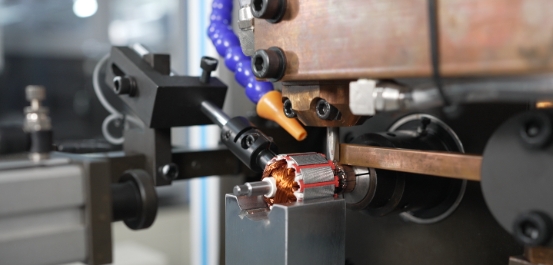What are the common electrical failures and solutions for motor motor rotor (single station) spot welder?
Motor motor rotor (single station) spot welding machine common electrical faults and solutions are as follows:

1、the machine does not respond: if you step on the foot switch machine does not respond, may be due to incorrect wiring, the power is not on. The solution is to change the wiring, close the main power switch.
2、 the electrode does not move: the power can start, but the electrode does not move, may be due to not connected to the air source, air pressure problems, air leakage, solenoid valve wiring error or disconnection, solenoid valve bad. The solution is to connect the air source, check the air pressure meter, change the air tube, connect the solenoid valve line or replace the electromagnetic valve.
3、no welding current: power start, electrode action but no welding current, may be due to incorrect wiring, electrode is not in place. The solution is to change the wiring, or adjust the electrode stroke.
4、poor welding results: welding monitoring value is normal, but the welding effect is poor, may be due to changes in the conditions of the workpiece, workpiece shunt or power output short circuit. The solution is to control the quality of the workpiece, avoid shunting or adjust the parameters, eliminate short circuit.
5、monitoring value is not normal: just started welding, overheating alarm or monitoring value is not normal, may be the detection signal wiring problems. The solution is to check the detection signal wiring.
6、the current is out of order: the fault shows that the current is out of order, the possible causes are secondary short circuit, incorrect connection or component damage. The solution is to eliminate the short circuit, notify the manufacturer.
7、Monitoring over-limit or low-limit: Fault display monitoring over-limit or monitoring low-limit, the possible causes are incorrectly set monitoring limits, changes in the conditions of use, circuit changes or changes in the conditions of the workpiece. The solution is to reset the monitoring parameters, check the use conditions, reset the welding parameters, and control the quality of the workpiece.
8、 the net pressure is too high or too low: the fault shows that the net pressure is too high or too low, the possible causes are fluctuations in the power grid. The solution is to check the power grid, wait for normal.
9、the controller overheating: fault display controller overheating, may be due to the use of too large a parameter, the use of environmental temperature is too high, the cooling air outlet blockage or detection line broken. The solution is to reduce the welding speed, clean up the wind, reset the machine position, connect the detection signal line.
10、transformer box overheating: fault display transformer box overheating, may be due to the use of parameters is too large, the use of ambient temperature is too high, the transformer box cooling air outlet clogging or detection of signal line disconnection. The solution is to reduce the welding speed, clean up the wind mouth, reset the machine position, connect the detection signal line.
11、the output current is limited: the fault shows that the output current is limited, can not reach the set value, may be due to the load or circuit resistance is too large, the current can not reach the set value. The solution is to check the output circuit, reasonable configuration; reduce the current setting.
These are some of the common electrical faults and their solutions of the motor motor rotor (single station) spot welding machine, specific problems may require more detailed diagnosis and professional maintenance.
※ If you still can't solve the problem by the above ways and means, please contact the technical specialist of Xinhui Electromechanical Equipment Co., Ltd. through the page chat tool for help.
The following is a case study about the electrical faults and solutions of motor motor rotor (single station) spot welding machine:
Case Description:
In the daily use of AC spot welding machine, some electrical faults may occur, affecting the productivity. The following is a case study and solution for a specific fault.
Fault phenomenon:
The spot welder has an unstable welding current during the welding process, which leads to a decrease in welding quality and substandard strength of the welded joints.
Fault cause analysis:
l Power supply voltage instability: power supply voltage fluctuations may lead to unstable welding current.
l Loose power cord or poor contact: power cord connection problems may lead to unstable current supply.
l Mismatch of welding materials or unclean surface: material problems affect welding quality.
Solution:
lCheck whether the contact of the power cord and plug is good: Make sure the power cord and plug are connected stably without loose or poor contact.
lUse a stable power source: If the grid voltage is unstable, consider using a voltage regulator to provide a stable power source.
lReplace the matching welding material: Make sure the welding material matches and the surface is clean to improve the welding quality.
l Adjust the welding current: Adjust the welding current according to the material and welding requirements to get stable welding effect.
The above solutions can effectively solve the electrical faults of unstable welding current encountered by spot welders in the process of manufacturing motor rotors, thus improving welding quality and productivity.







